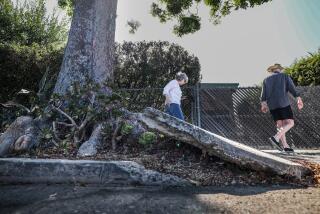A Haven for Diehard Skateboarders
- Share via
On this afternoon, Reese Simpson is king of the “verts,” the steep, vertical sides of the awesome new, 12-foot-high skateboard ramp at the Encinitas YMCA. The ramp looks like a large wooden back-yard swimming pool, elevated above ground, with one end open so that boarders who crash and slide to the bottom can escape.
Simpson earns hoots from his 20 or so adolescent male admirers for each gnarly stunt. They ring the bowl on a plywood catwalk, peering down at the action, wearing baggy skateboarding shorts and T-shirts, helmets, knee pads and high-tops.
Heavy metal pumps out of a cheap stereo that adds to the music’s fuzzed-out sound. Shirtless, his back tanned deep brown from long afternoons of skateboarding, Simpson drops into the bowl, streaking down one side and up the other, where his momentum launches him several feet into the air above the vertical wall. Knees bent, he grabs his board with one hand, spins 180 degrees in a move known as “backside air” and drops back into the bowl for a smooth landing.
Now he shoots up the other wall and performs a feat of balance that would make Nadia Comaneci proud. He turns his board so that both sets of wheels straddle the bowl’s lip. And he skids along for several yards this way, metal grating on metal in a textbook “grind.”
The Y is the busy hub of a red hot North County skateboarding scene. Several world-class pro skateboarders live in North County, including Tony Hawk, Mike McGill, Chris Miller and Kris Marcovich. Hawk, McGill and Miller are among past and present skateboard champs who also run their own skateboarding-related businesses in North County.
McGill owns a skateboard shop in Encinitas. Hawk and Miller, who are good friends, both offer their own lines of skateboards, T-shirts, stickers and other vital equipment. Also, Transworld Skateboarding, the monthly magazine for serious skateboarders, is published from offices in Oceanside.
Once upon a time, North County skateboarders could choose from among several skateboard parks, including veteran skateboarder McGill’s place at the Carlsbad Raceway and parks in Del Mar and Escondido.
But with cities’ liability fears mounting and liability insurance hard to come by for park owners, the parks all closed during the late 1980s, leaving the Encinitas YMCA as the only public skateboarding park in the county.
The demise of skateboarding parks has driven skateboarders either to the Y, or to the streets in search of fresh terrain. Each vacant parking lot, schoolyard, sidewalk and man-made obstacle beckons.
Skateboarding is a sport dominated by males. At the Y, only 10 of 800 skateboarding members are female.
Much of the time it’s a loosely organized sport, often coming together like a game of pickup basketball or touch football.
On a recent typical Saturday, Rob Dotson, 22, who works at Street Life skateboarding shop in Encinitas, began calling fellow boarders in the morning to see what’s up. By 12:30, 15 boarders were skating in the parking lot of a now-defunct business in Encinitas. Later, they moved to a larger empty lot a couple blocks away. They didn’t quit boarding until sundown.
On a Sunday afternoon at McGill’s skateboard shop, Adam Spiro, 13, and Travis Kelly, 13, sprawled on chairs watching skateboarding videos, boards at their feet.
Spiro, Kelly and Dotson all agree that what they like about the sport is its individual nature.
“There’s no coach who tells you what to do,” Spiro said. “You learn by yourself, and there are no limits to what you can do.”
As skateboarders have taken to the streets, North County has been forced to come to terms with skateboarding.
It’s been a struggle. Attitudes toward the sport vary widely among property owners, public officials and law enforcement officers.
For some, the skateboard has come to symbolize the young and restless--or reckless. Those who love the sport say it’s a misleading image and argue that while some boarders do skate with little regard for the rights of pedestrians and motorists, all boarders should not be penalized.
In most North County cities, it is against the law for skateboarders to interfere with pedestrian or auto traffic, or to skateboard on private property where a sign is posted that forbids skateboarding.
But interpretations of these municipal codes can vary. Some skateboarders receive only a verbal warning, while others are issued citations that carry fines of $50 or more.
Some skateboarders said they seldom run into trouble in Encinitas, for example, while others report being stopped often by law enforcement officers in San Marcos.
Veteran pro skateboarder McGill, 27, ran a thriving skateboard park at the Carlsbad Raceway for three years until closing it early this year. McGill wants to reopen, but says he is fighting the high cost of liability insurance required by his landlord, along with the city of Carlsbad’s policies toward skateboarding.
“They’ve outlawed skateboarding and they’ve given me nothing but grief the past three years over my park,” McGill said. “Then they give my customers, 14-year-old kids, $110 tickets for riding down their boardwalk. They’ve been hassling us about every little thing. They say we need building permits for our ramps. They’re all portable, there’s no such thing as a building permit. If this doesn’t work out, we’ll have to find another place.”
Last year, pressured by downtown business owners, Carlsbad enacted an ordinance that bans skateboarders from two public parking lots and a sculpture park downtown.
In an unrelated move, the city earlier told McGill that he needs a conditional use permit to operate his park. So far he has not met their requests for plans that would attest to the structural integrity of his ramps, according to Senior Building Inspector Pat Kelly. The city told him not to use one large ramp it deemed unsafe.
Another North County skateboarder, Gregg Marte, said he tried to open an indoor skateboarding park in Oceanside, Vista or Escondido last year, but costly liability insurance, inflexible local zoning laws and uninterested public officials kept him from moving forward.
In Vista, for example, Marte said he located a 9,500-square-foot warehouse where he wanted to put his park, but local officials said such a use was not appropriate for that commercial zone.
“In the Bay Area, they have several skate parks,” Marte said. “If public officials here would only look at this as an enhancement. . .”
City planning officials in Vista said they hadn’t heard of Marte, and were unaware of his plans. Marte said he has given up on opening a park.
Meanwhile, as the number of places officially available to skateboarders decreases, the greater is the temptation for skaters to use unauthorized areas.
One thing that hasn’t diminished, though, is interest in the sport.
Those who first skateboarded by nailing old roller skates to a hunk of wood and cruising across the driveway will be stunned by what today’s hottest boarders, most of them in their teens, can do.
At ramps like the YMCA’s, they execute all manner of death-defying aerials. On the street, they pride themselves on the ability to skate any surface. “Ollie-ing” is one essential move. It involves suddenly jamming the back of the board against the ground, which sends the nose skyward and launches both board and boarder into the air. Good boarders can ollie up onto curbs and benches or over tall obstacles. Skateboarders have also been known to slide down steel banisters, skid across retaining walls or vault down stairs.
All this adrenalin-pumping fun can carry a price. Most skateboarders have at least some battle scars. Hawk, whose boarding accomplishments include a 720-degree aerial spin off a vertical ramp, tore cartilage in his knee two years ago. He was back on his board a month after arthroscopic surgery.
Simpson, 24, has been a top ranked professional, but hasn’t competed much since shattering his wrist in an Australian contest two years ago. Stephen Bailey, 16, an accomplished regular at the Encinitas Y, said he has been knocked unconscious by a couple of falls, but still feels no fear.
Overall, though, experts say skateboarding is no more dangerous than most other sports.
“We’ve had a broken ankle and a couple of broken wrists, but those were the only ones that required the emergency room,” said Rob Rolley, who directs the skateboarding program at the Y. “It’s not any more dangerous than our soccer program or surfing camp. We have just as many injuries there.”
Modern equipment helps. At the Y, all skateboarders must wear helmets and tough, shock-proof knee pads.
The YMCA’s skateboarding park, with its many ramps and obstacles, ranging from small to the huge monster ramp that opened the first weekend of April, attracts experienced boarders as well as those just beginning to learn the sport. There are always two supervisors on hand.
Eight hundred skateboarding Y members pay $15 annual dues, plus $3 (weekdays) or $5 (weekends) for each skateboarding session. The Y limits park use to 55 people at a time. When the big ramp made its debut, the place was full, evidence of the pent-up demand for first-class “verts.”
To some, skateboarders may seem an unruly lot, with their baggy clothes, loud music and aggressive boardsmanship. But boarders are mostly average teen-agers just looking to have some fun.
“These are kids like yours or mine or anybody’s,” said Richard Everett, the father of skateboarding sons and the owner of Stix Skateboard Warehouse in San Marcos.
“They aren’t unique, just people who enjoy a particular activity. . . . They come from all walks of life. There are physicians and lawyers that skateboard. Whatever you can find in society you can find in skateboarders.”


